North Carolina is a gorgeous state with cities, mountains, coastal beaches, and so much more!
As well, it’s home to countless types of birds, each with its own unique appearance, habitat, and behaviors. North Carolina is a birder’s dream state!
Ducks are a fun challenge for many birders. There are so many kinds of ducks, but some can be quite difficult to differentiate. However, using knowledge of ducks’ appearance, migratory habits, vocalizations, and behaviors can help you figure out which one is which!
This list is designed to give you an overview of the most common ducks in North Carolina. Some of these 19 ducks can be found year-round in the state, while others will only be spotted in the winter.
Some prefer North Carolina’s saltwater coastline, whereas others stick to freshwater marshes and ponds.
Let’s take a look at some of the ducks you’ll see if you pay attention to the birds in the Old North State!
But First! Dabbling Ducks vs. Diving Ducks
There are two main categories of ducks in North America.
The first group is made up of dabbling ducks, which stick their bill underwater and their tail straight into the air as they “dabble” for food on the bottom.
These ducks love shallow water, where it’s easy for them to reach for aquatic plants, insects, larvae, and crustaceans.
The second group is called the diving ducks. They go all the way under the water, submerging themselves to dive deep down to the bottom for food. They are perfectly comfortable in deep water, including rivers, ocean inlets, and bays.
A diving duck, on the other hand, has no problem diving under the water and completely disappearing in search of food. These birds will live and feed in large, deep bodies of water, including lakes, rivers, ocean inlets, and bays.
North Carolina has a lot of both of these kinds of ducks, so our list will identify whether each type is a dabbling duck or a diving duck.
In alphabetical order, here are the ducks in North Carolina.
American Black Duck (Dabbling Duck)
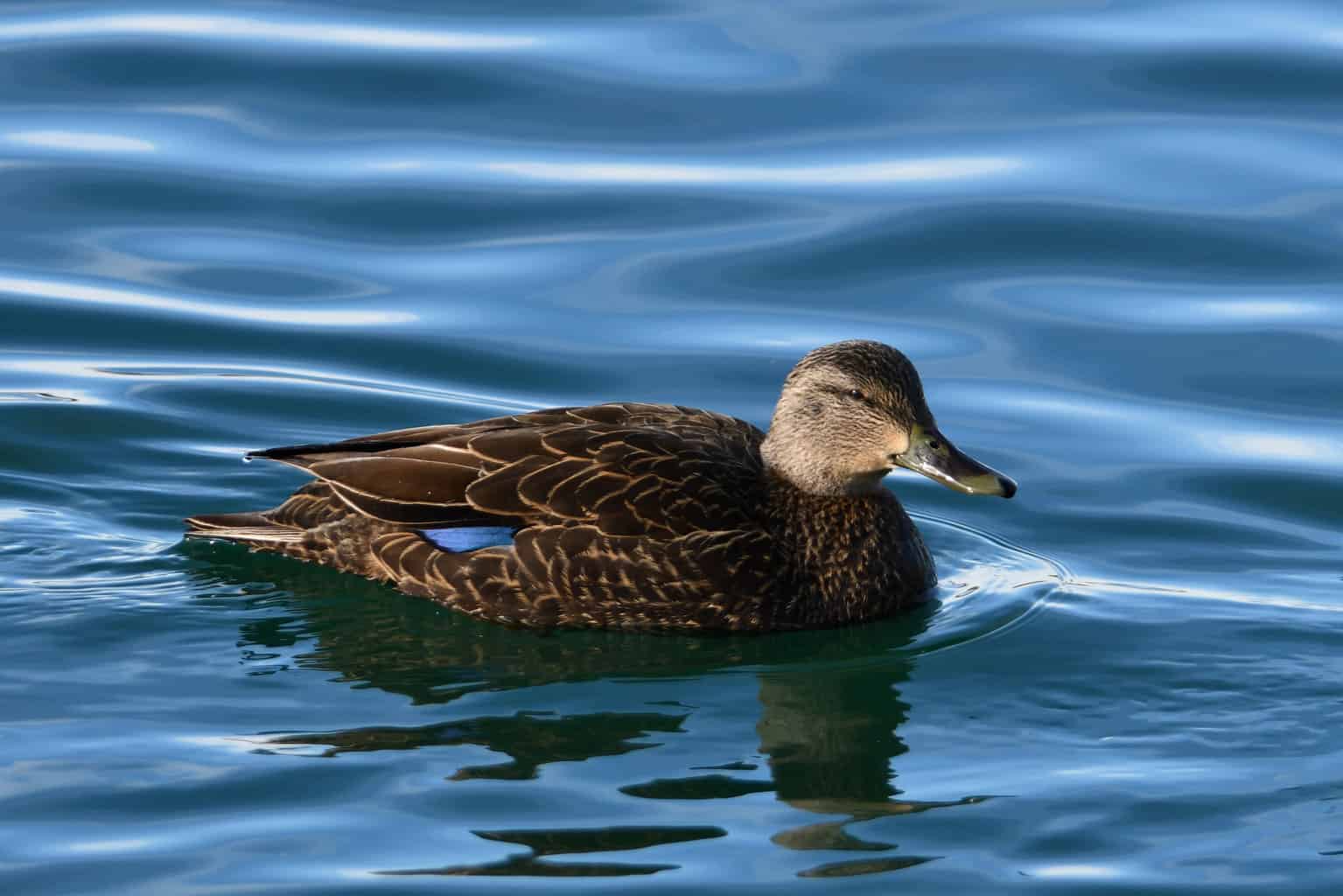
- Scientific Name: Anas rubripes
- Length: 21.3-23.2 inches
- Weight: 25.4-57.9 ounces
- Wingspan: 34.6-37.4 inches
The American Black Duck isn’t exactly black and white, but more of a very dark brown. Their heads are paler, and they have greenish-yellow bills.
Females and males are similar in appearance, but females are a bit lighter in color. Also, females’ bills are greener and less yellow.
Both males and females have bright white underwings and gorgeous purplish-blue speculum.
These ducks are found exclusively in the eastern half of North America. They breed in Canada and spend the winter in New England, the Midwest, and the Southeast.
The American Black Duck’s habitat includes both saltwater and freshwater wetlands.
In North Carolina, American Black Ducks are exclusively winter birds. They will be gone by spring and return in the fall.
American Wigeon (Dabbling Duck)

- Scientific Name: Mareca americana
- Length: Up to 14 inches
- Weight: About 2.25 pounds
- Wingspan: 34 inches
The American Wigeon is small and compact. Males are easy to recognize because of the green band that starts right behind their eyes and runs to the back of their head, as well as a thick white crown. Female American wigeons have brown bodies and gray heads.
Both males and females have a black-tipped grayish-blue bill. American Wigeons use those strong bills to pull aquatic plants from the bottom of the river or pond where they live.
In the winter, they live in the coastal waters of North Carolina. They can only be seen in the eastern half of the state when they’re migrating to the far northwest and Canada for the breeding season.
Blue-Winged Teal (Dabbling Duck)
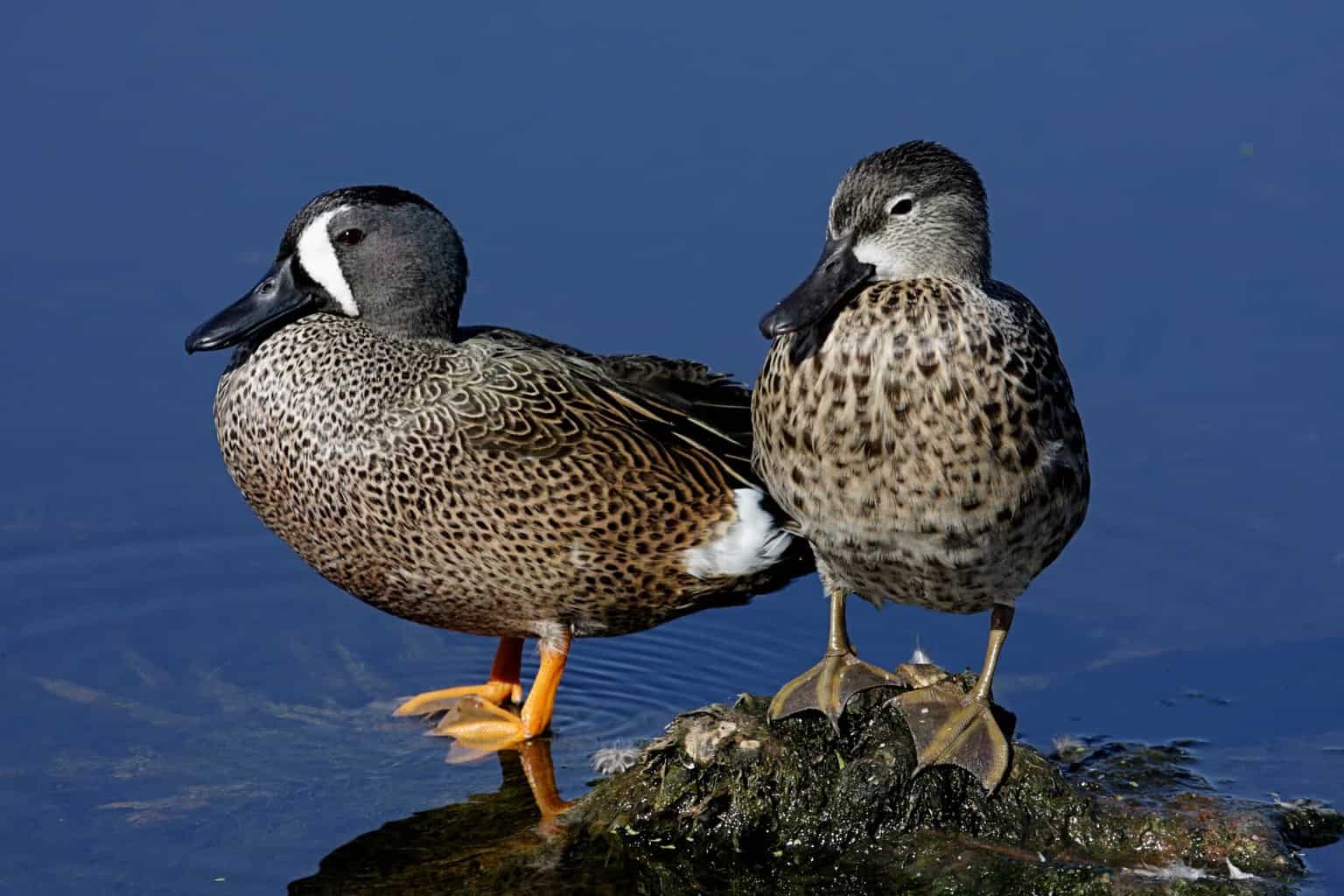
- Scientific Name: Anas discors
- Length: 16 inches
- Weight: 13 ounces
- Wingspan: 23 inches
You may start to notice a trend that many of North Carolina’s ducks spend much of the winter in the eastern half of the state, where they have easy access to coastal waterways. The Blue-Winged Teal Duck is one that fits this pattern!
Male Blue-Winged Teal Ducks change significantly in appearance from breeding to non-breeding season.
While breeding, the male will be mostly brown, with a speckled breast and a white patch near his tail. He’ll have a grayish-blue head with a white stripe running from above his eye down the front of his face.
Females, juveniles, and non-breeding males are similar in appearance, but they lack the dark coloration of summertime males. These ducks are plain brown and have a blue patch on their wings that you can only see when they are flying.
Bufflehead (Diving Duck)
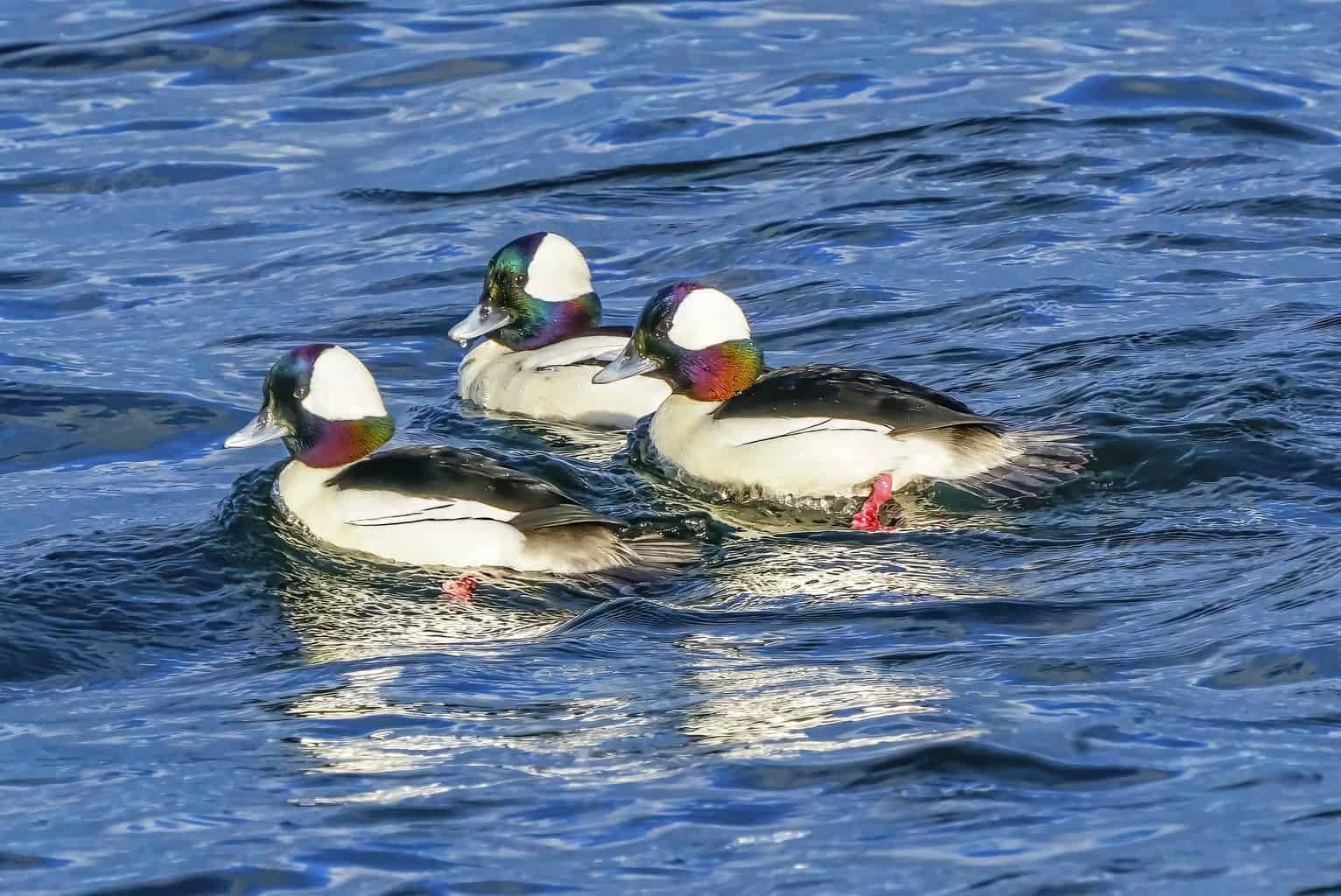
- Scientific Name: Bucephala albeola
- Length: 13-16 inches
- Weight: 11-16 ounces
- Wingspan: 22 inches
The name “Bufflehead” comes from the odd shape of this duck’s large head. It is derivative of “buffalo-head.”
One of the reasons why the Bufflehead’s head is so noteworthy is that it sits atop such a small body. Like a buffalo’s head, it’s quite fluffy!
Buffleheads are actually the smallest diving duck in North America. Males have a white body, black back, and an iridescent green and purple head.
Across the back of its head is a large white patch, which gives the head a segmented look.
Juvenile males and females are much plainer in appearance. They are brownish-gray with a large, oval-shaped white patch on the cheek.
As migratory birds, Buffleheads spend the winter in most of the United States. In North Carolina, they find their way to slow-moving rivers, shallow lakes and ponds, and safe, protected bays.
They are cavity nesters, and they often take over the abandoned nests of Northern Flickers.
Canvasback (Diving Duck)
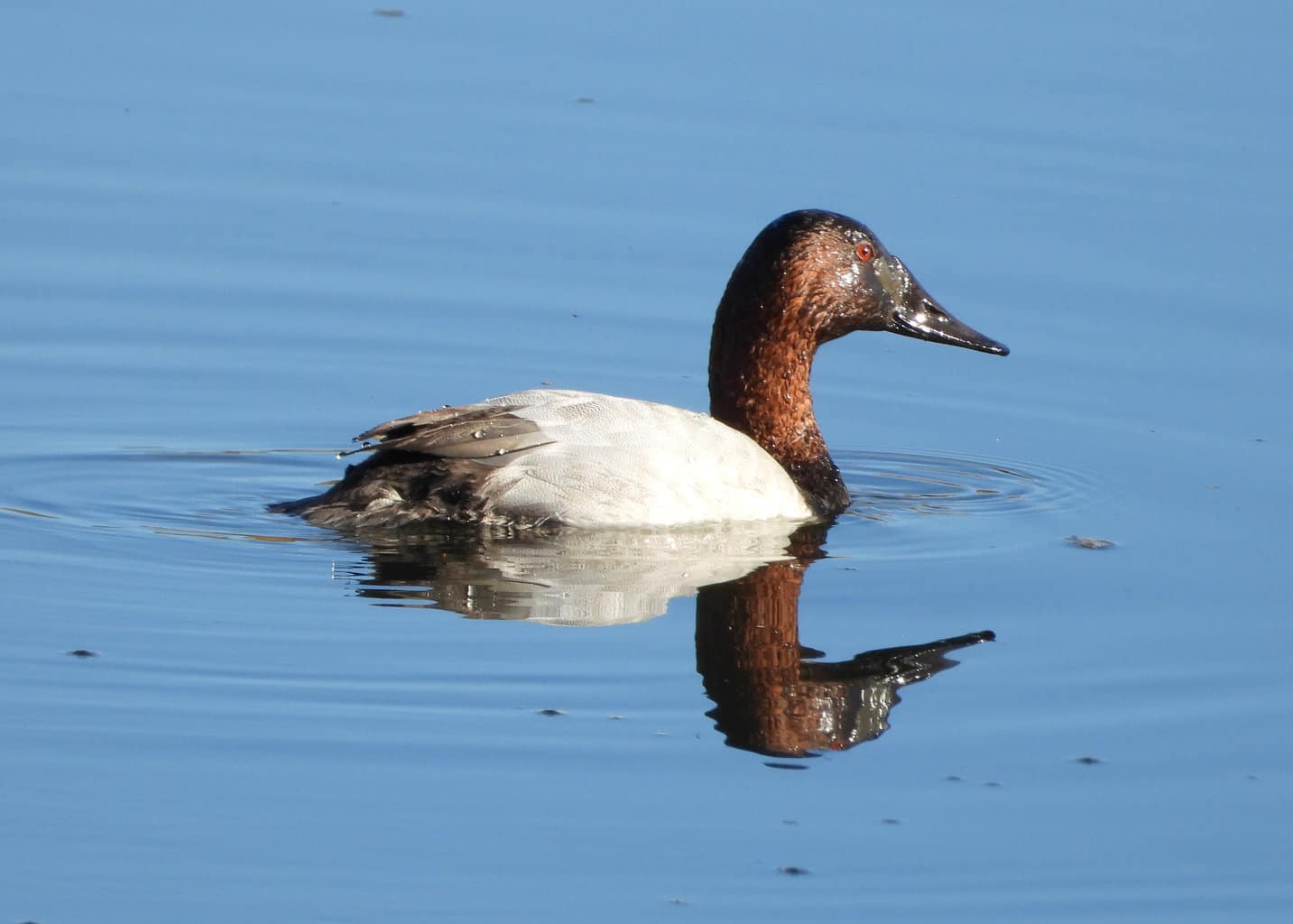
- Scientific Name: Aythya valisineria
- Length: 13-16 inches
- Weight: Up to 2.5 pounds
- Wingspan: Up to 3 feet
This is a speedy duck! Canvasback ducks are on record flying up to 72 miles per hour, which is 30 miles per hour faster than the average duck.
All Canvasbacks have thick necks, big heads, and long bills. Males are chestnut brown, black, and white, while females are light brown.
Their eye color is actually a great way to differentiate them, too, as females have dark eyes and males have red eyes.
Canvasbacks sometimes participate in brood parasitism, which is when a female lays eggs in another bird’s nest.
Unlike Brown-Headed Cowbirds who lay their eggs in the nests of totally different bird species, female Canvasbacks will sometimes lay eggs in the nests of other female Canvasbacks.
As well, if a Ruddy Duck or Redhead lays their eggs in her nest, the Canvasback will raise them as her own!
Like many North Carolina ducks, you’ll only spot the Canvasback in winter. Importantly, Canvasbacks stick to the east coast of the state. You’ll only see them west of Durham during their migration.
Common Goldeneye (Diving Duck)
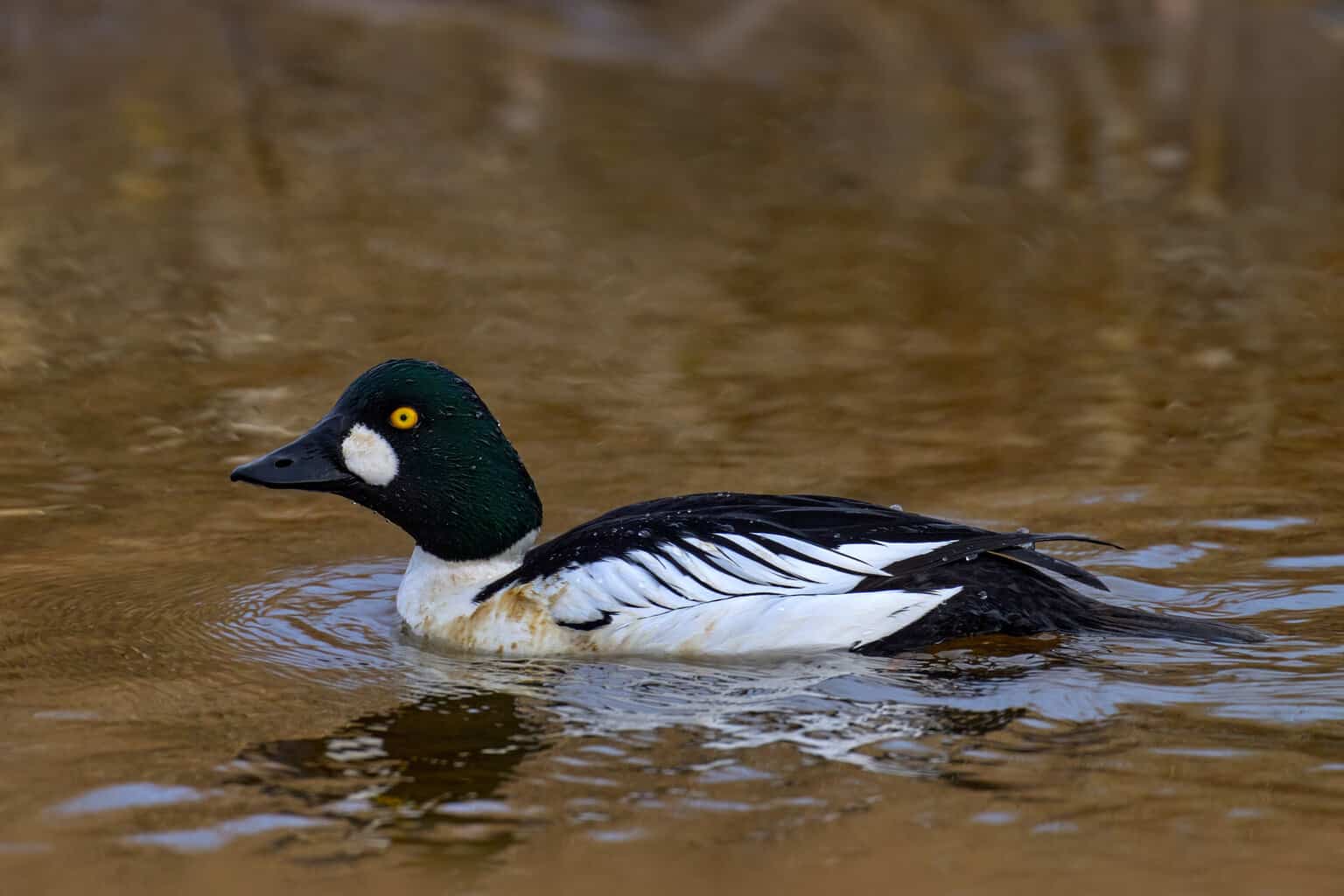
- Scientific Name: Bucephala clangula
- Length: 16-20 inches
- Weight: Approximately 1.8 pounds
- Wingspan: 30.3-32.7 inches
Goldeneye Ducks get their name from their bright yellow eyes, which can be spotted from quite a distance.
Though both males and females have these bright eyes, the rest of their features are sexually dimorphic.
Males have green feathers that are so dark that from a distance, they appear black and white instead of green and white. Females are gray with brown heads, while both sexes have white wing patches.
North Carolina sees Goldeneye Ducks throughout the state in the winter. They are deep divers, so they’re comfortable in much deeper waters than dabbling ducks.
In fact, Goldeneyes will dive underwater for up to a minute at a time. Their habitat includes large lakes, deep rivers, and other coastal waterways.
Goldeneyes nest in tree cavities, sometimes up to 40 feet in the air. This is a pretty big challenge for their babies, who have to leave the nest at just one day old! As the mother calls to the babies at the base of the tree, they drop down from the nest, one at a time.
Gadwall (Dabbling Duck)
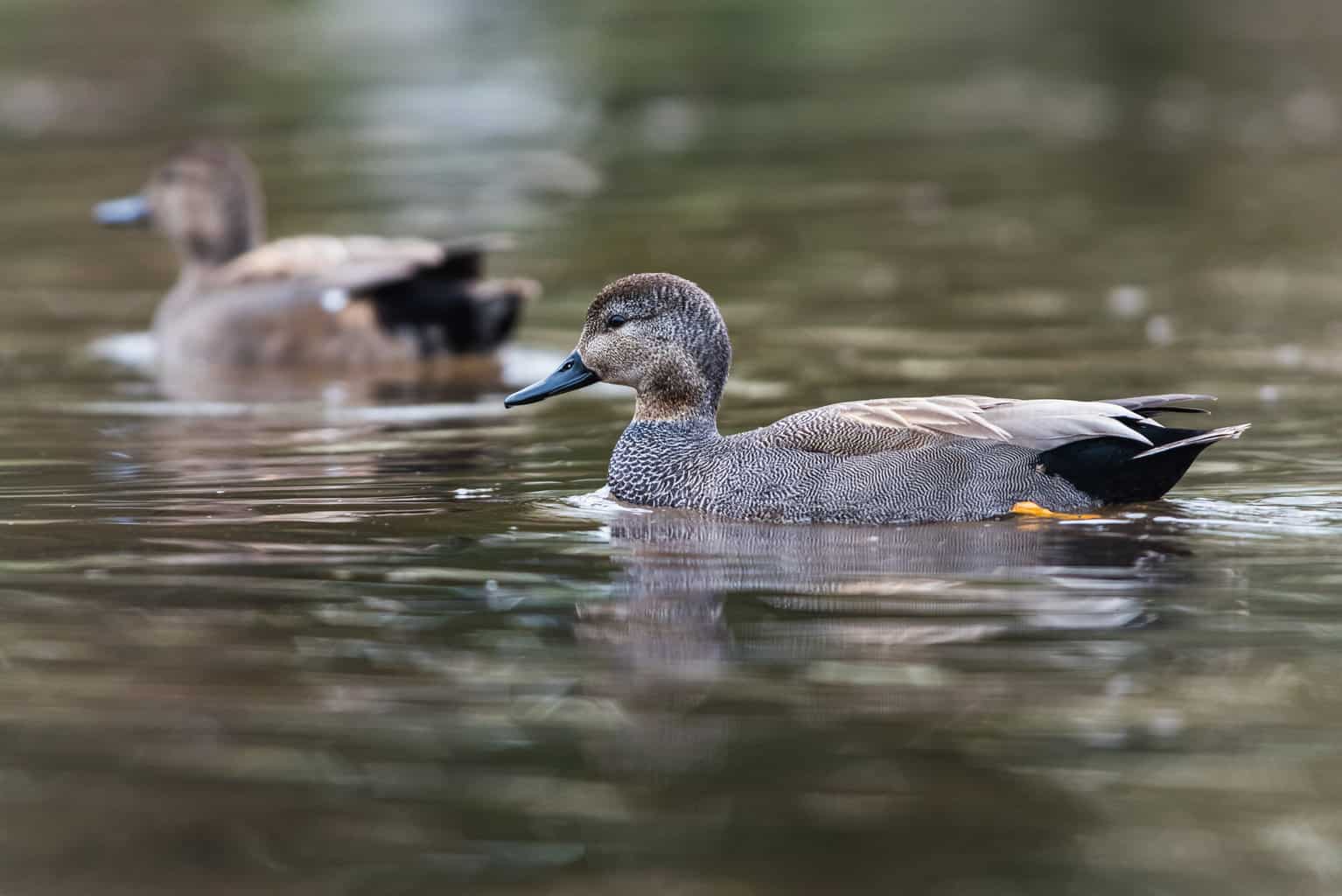
- Scientific Name: Mareca strepera
- Length: 18.1-22.4 inches
- Weight: 17.6-44.1 ounces
- Wingspan: 33.1 inches
Most dabbling ducks spend the winter in shallow water, as they have to be able to reach from the surface to the bottom of the water without submerging themselves.
Gadwall Ducks are able to reach a bit deeper than other dabbling ducks, but they still don’t dive deep under the water like a sea duck.
The head of a Gadwall Duck is sometimes described as square-shaped. The blocky head is in contrast to its thin bill and neck.
Gadwalls aren’t very colorful. Males are gray and brown, and females are brown and creamy-white. Both sexes have a white patch on their wings, which should be visible while they are swimming.
Gadwalls spend the winter months in North Carolina’s marshes and estuaries. They are excellent at camouflage, and it can be difficult to see them if they are in the cattails and aquatic grasses that fill many wetlands.
Gadwalls also have an amusing trait – well, it’s amusing to us even if it’s not amusing to other ducks – they like to play the part of pond thief.
Gadwalls will steal food from other ducks as they come to the surface. Talk about a free lunch!
Greater Scaup (Diving Duck)
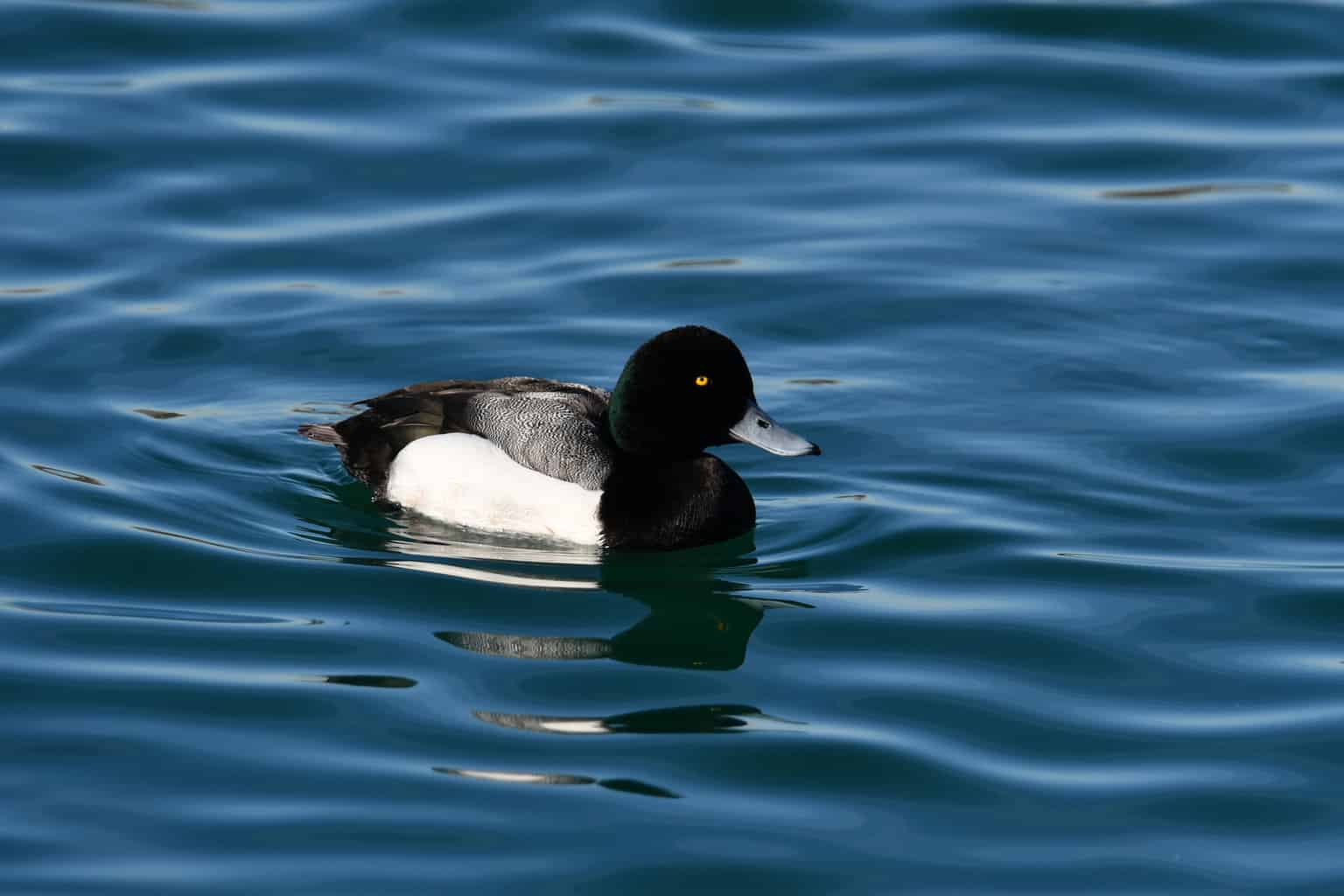
- Scientific Name: Aythya marila
- Length: 15-22 inches
- Weight: 1.5-2.9 pounds
- Wingspan: 28-33 inches
Also called the Bluebill, the Greater Scaup has dark green feathers that appear black from far away. Males have a slate-blue bill, whereas females have a slightly darker bill that still has a blueish hue.
Females are light brown with dark brown heads. During the non-breeding season, males look like a hybridized breeding male and female Greater Scaup.
The non-breeding male has a gray and brown body with a dark gray or almost black head.
Greater Scaup is pretty rare in North Carolina. You might find them along coastal waterways during the winter, but they aren’t regular visitors to the state.
Green-Winged Teal (Dabbling Duck)
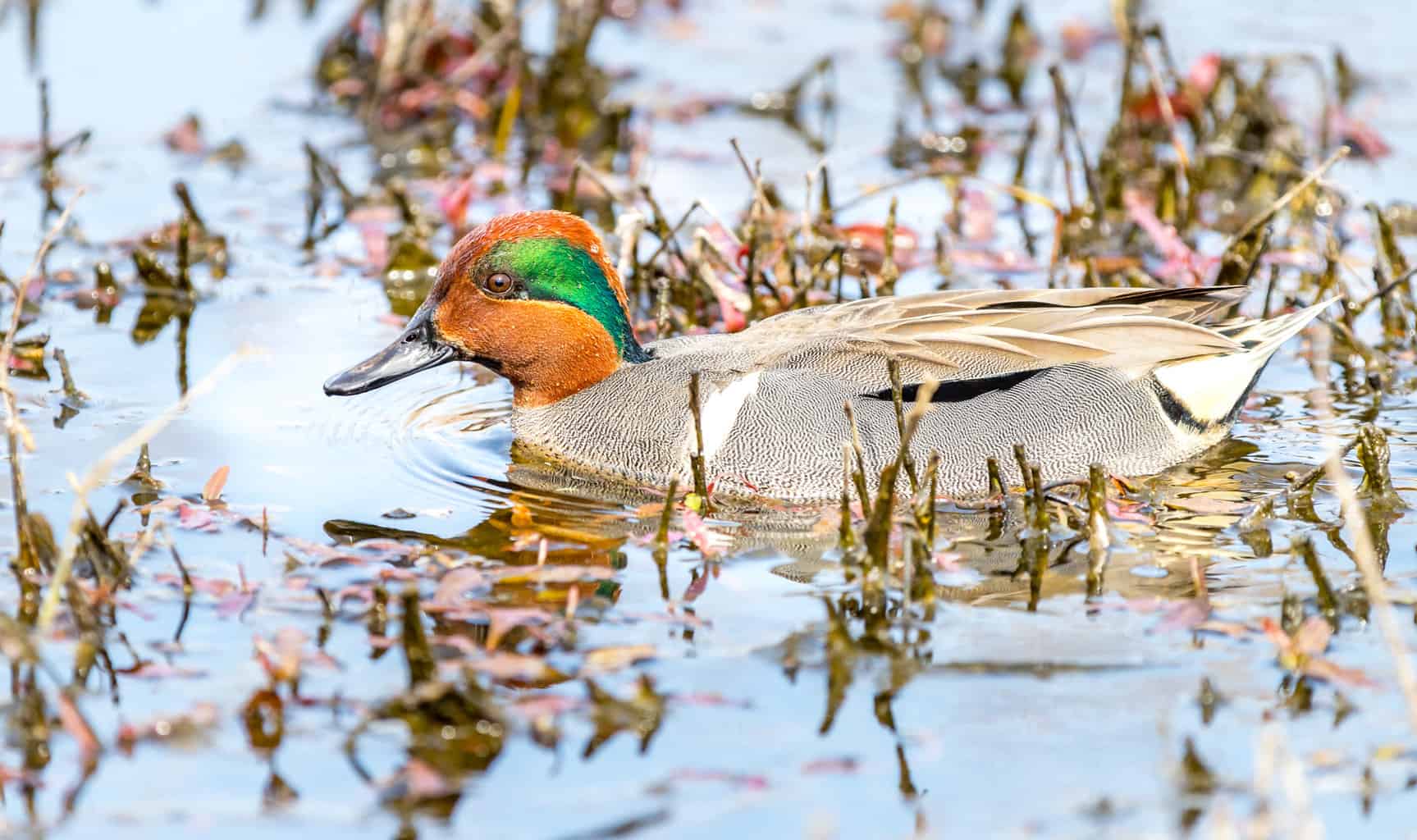
- Scientific Name: Anas carolinensis
- Length: 12.2-15.3 inches
- Weight: 4.9-17.6 ounces
- Wingspan: 20.5-23.2 inches
Male Green-Winged Teal Ducks are quite flashy. Males have a bright, shimmering green stripe from their eye to the back of their head, which is otherwise dark coppery brown. Females are brown all over, with light brown barring on the wings.
Both males and females have a shiny green speculum, which is the name for an iridescent patch of color on a duck’s secondary wing feathers.
These are the smallest dabbling ducks in North America, and some of them spend the winter in North Carolina’s waterways. They thrive in flooded agricultural fields and river deltas.
Hooded Merganser (Diving Duck)
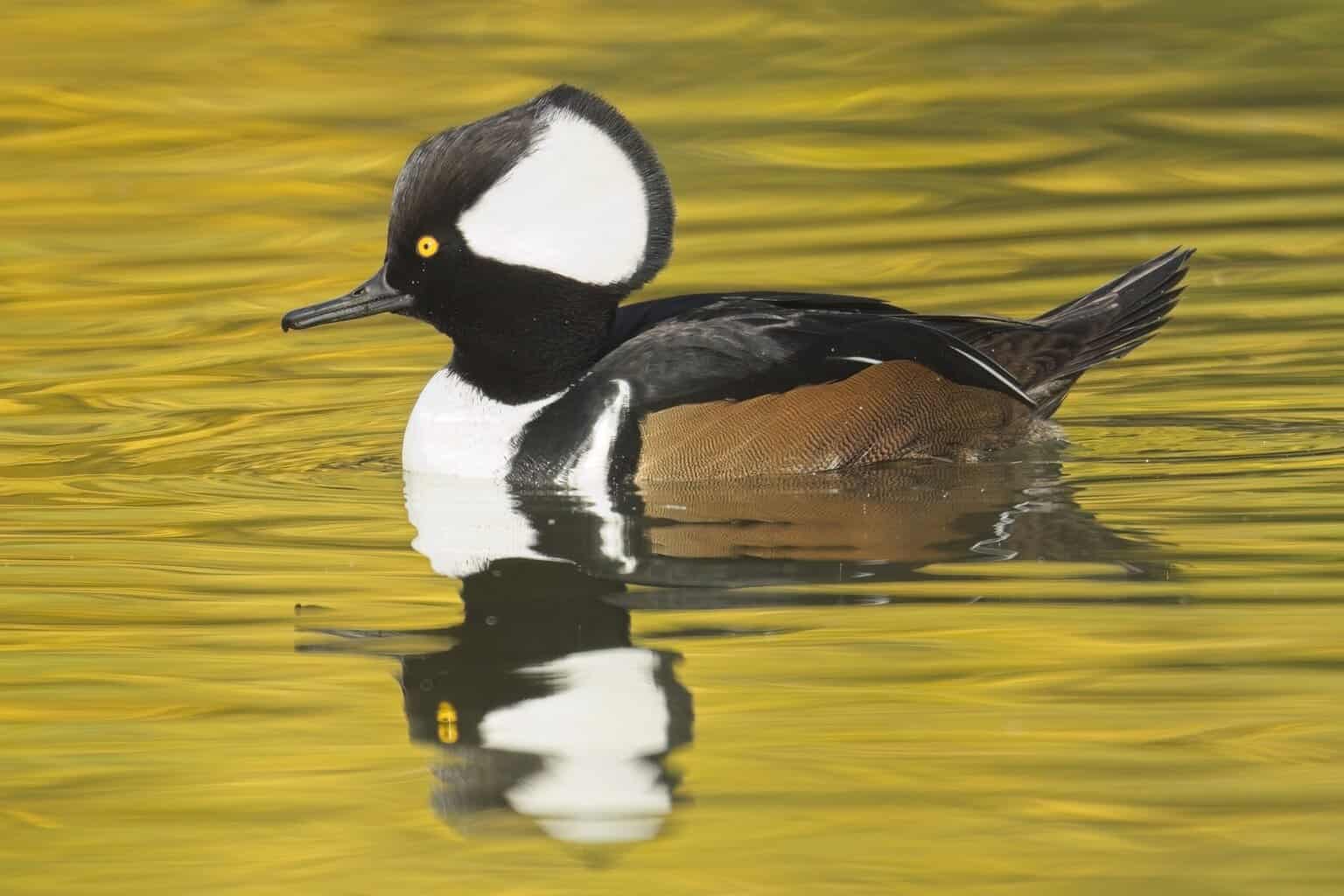
- Scientific Name: Lophodytes cucullatus
- Length: 15.8-19.3 inches
- Weight: 16-31 ounces
- Wingspan: 23.6-25 inches
Hooded Mergansers are easily identified by their dramatic, oversized crests. Males have a flashy black and white crest, while the female crest is cinnamon-colored.
As well, Hooded Mergansers are year-round residents in North Carolina! Instead of only getting to see these stunning ducks in the winter, you have the opportunity to see Hooded Mergansers all year long.
These ducks use their nictitating membrane (a transparent, extra eyelid) to protect their eyes underwater while they swim and find crustaceans, fish, and invertebrates on the bottom of the water.
This membrane acts like a pair of goggles, offering both protection and clear vision.
Lesser Scaup (Diving Duck)
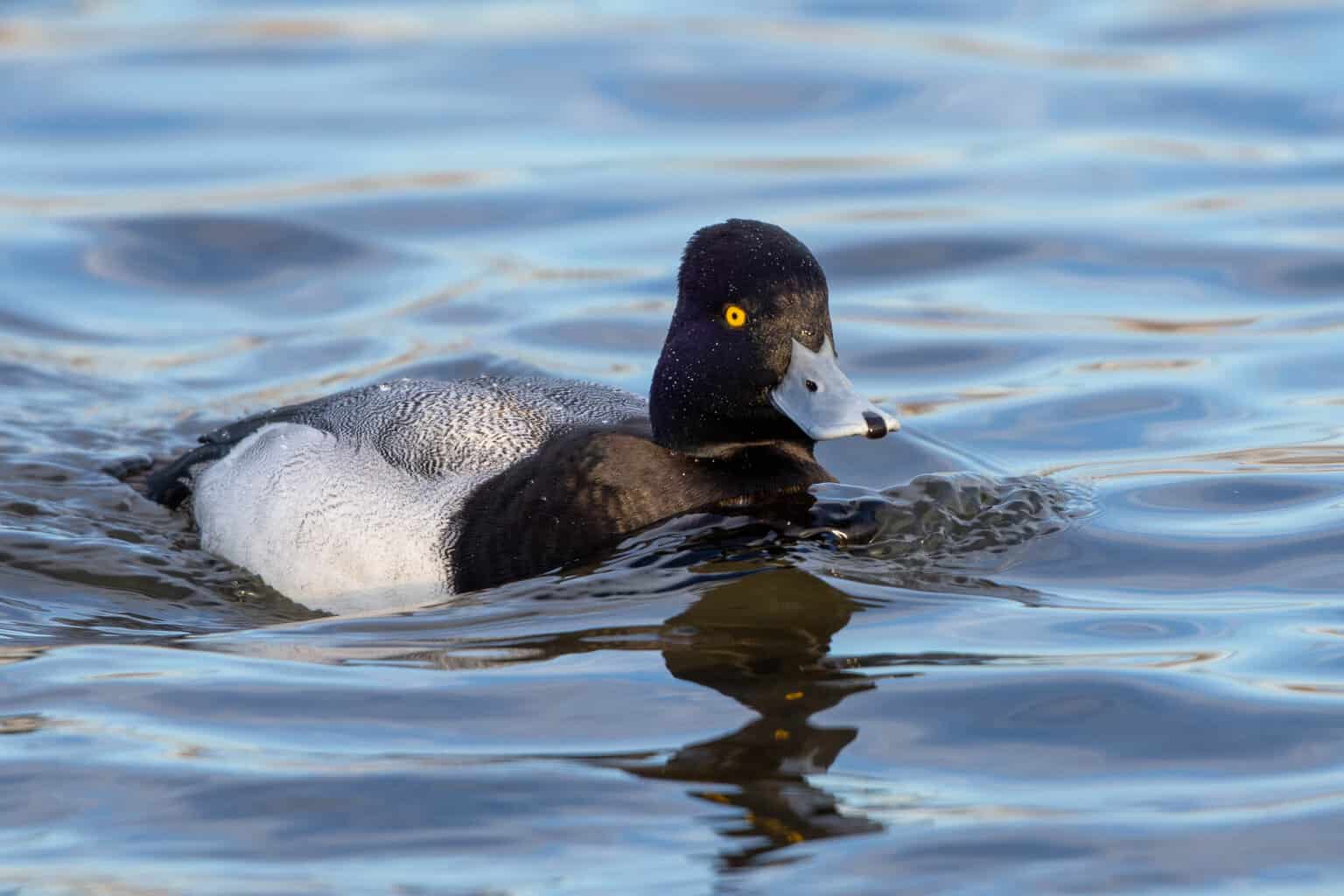
- Scientific Name: Aythya affinis
- Length: 15.3-18.1 inches
- Weight: 16-38.4 ounces
- Wingspan: 26.8-30.7 inches
Lesser Scaup looks a bit like Greater Scaup, but there are some subtle and important differences between these two different ducks.
The biggest visual difference is that the Greater Scaup has a rounded head and the Lesser Scaup has an egg-shaped head. Sometimes it can be hard to see this from a distance.
First of all, their similarities: Both Lesser Scaup and Greater Scaup males are often mistaken for being black and white when really they’re iridescent green or purple and white.
Females of both varieties have similar patterns as the males, though different colors. They have dark brown heads and light brown bodies.
Lesser Scaup spends the winter along in warmer bodies of water, from the coast of California, across the southern United States, and up the east coast.
In the winter, they will be in freshwater lakes, ponds, and rivers. By contrast, Greater Scaup has a preference for seawater in the winter.
They are only found along the North Carolina coast, so you’re unlikely to see them west of Raleigh.
Mallard (Dabbling Duck)

- Scientific Name: Anas platyrhynchos
- Length: 20-26 inches
- Weight: 1.5-3.5 pounds
- Wingspan: 32-39 inches
Is there any duck more iconic than the Mallard? Mallards are one of the most recognizable duck breeds in North America. You can find Mallards on home decor, in artwork, and even as jewelry pendants.
Most domesticated ducks in North America descended from Mallards, which was possible because of how frequently Mallards breed with other kinds of ducks.
In fact, there is even a kind of duck in Floriday known as a “Muttled Duck” because Mallards and Mottled Ducks have interbred so frequently.
Male Mallards have dark, iridescent green heads. Females have mottled cream and dark brown bodies. Another easy-to-spot marker on the male Mallard is a bright white ring around his neck.
These widespread ducks can be found on multiple continents, including North America, Europe, Asia, and Africa. The ducks you see in North Carolina in the winter have migrated from Canada.
Northern Pintail (Dabbling Duck)
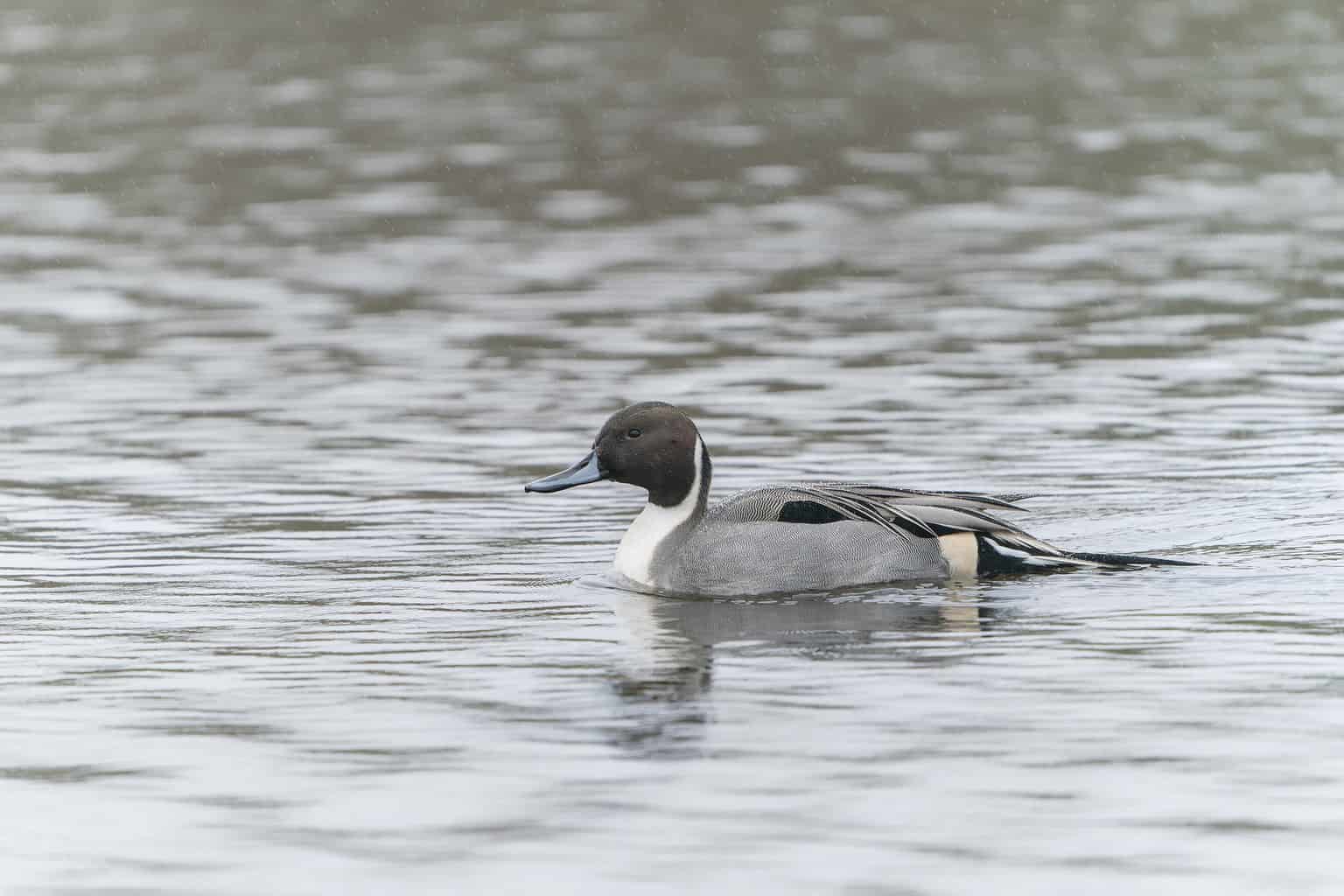
- Scientific Name: Anas acuta
- Length: 20-30 inches
- Weight: 1-3 pounds
- Wingspan: 20-30 inches
Northern Pintails get their name from the thin, pointed tail of breeding males. Females, juveniles, and non-breeding males have a more traditional silhouette.
Males always have a green speculum, regardless of the season, and females always have an iridescent brown speculum.
The breast of a breeding male is bright white, and his head and neck are dark brown. He has a white line that runs down his head and neck, while females have a very plain face that is light brown and without any markings.
Pintails reach North Carolina from Canada by flying up to 48 miles per hour. They only migrate at night, so you won’t see them in the skies during the daytime.
They can be found in the eastern half of the state in the winter, but they may be spotted in the western half during their migratory period.
Northern Shoveler (Dabbling Duck)
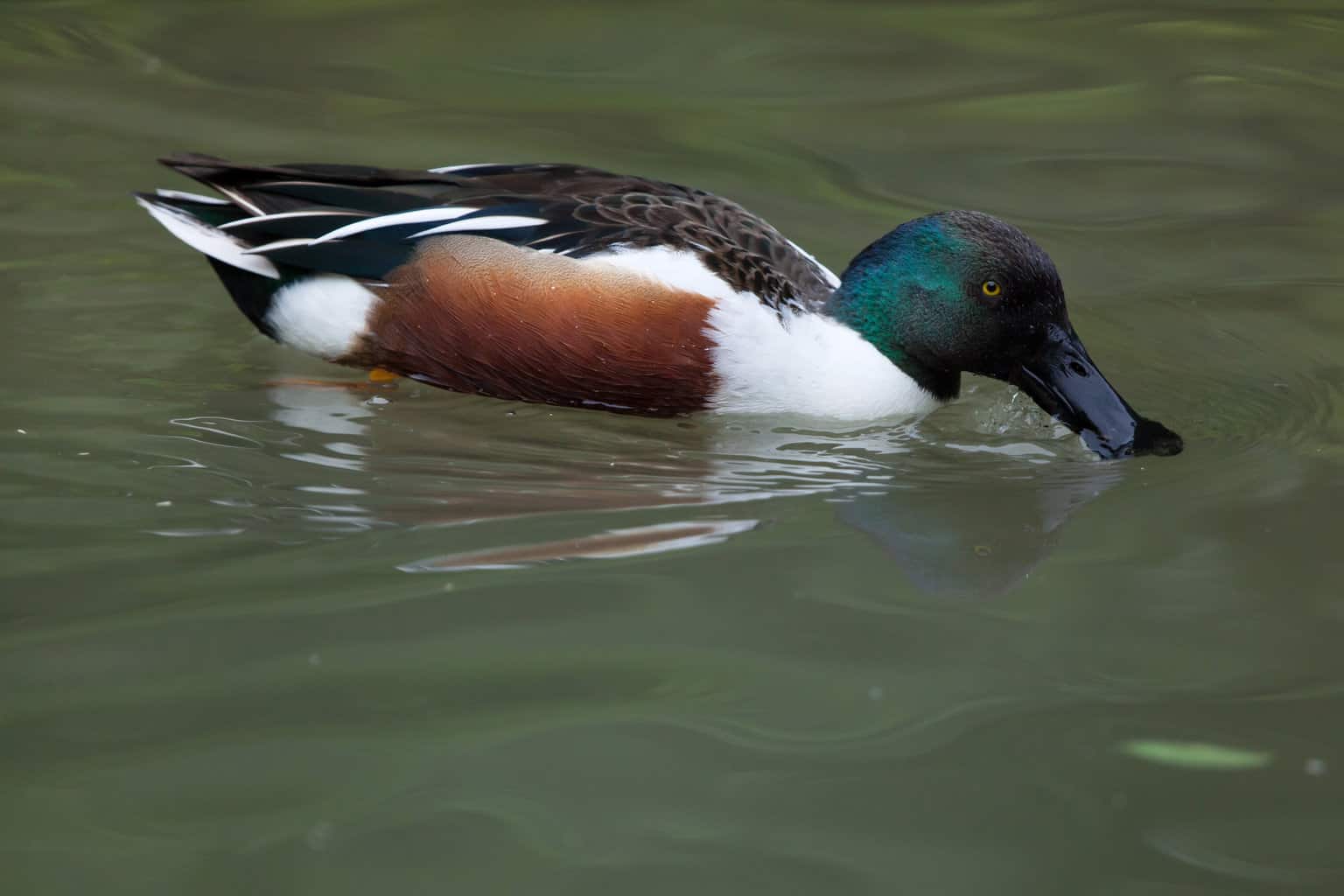
- Scientific Name: Spatula clypeata
- Length: 19 inches
- Weight: 1.3 pounds
- Wingspan: 30 inches
When you spot a Northern Shoveler, the first thing you’ll probably notice is its broad, shovel-shaped bill.
Breeding-season males are brightly colored in vibrant white, light blue, metallic green, and iridescent brown. They have a blue speculum on their wings and a black bill.
Juvenile males, females, and non-breeding males are mottled cream and dark brown, though they also have a slight hint of blue on their wings. Females have a noticeably bright orange bill.
Females also have an interesting but somewhat gross way of protecting their nests.
If they’re frightened and under attack from a predator, northern shovelers will flee the nest, but only after defecating all over their eggs! They do this in hopes of deterring the predator from stealing and eating the eggs.
Northern Shovelers aren’t unique to North America but are also present in Europe, Africa, and India.
In all of these regions, they choose coastal bodies of water, including marshes, lakes, lagoons, and wetlands.
They build their nests in the tall grasses at the water’s edge, which gives them great camouflage. Their diet is made up of insects, crustaceans, small fish, and aquatic plants.
Red-Breasted Merganser (Diving Duck)
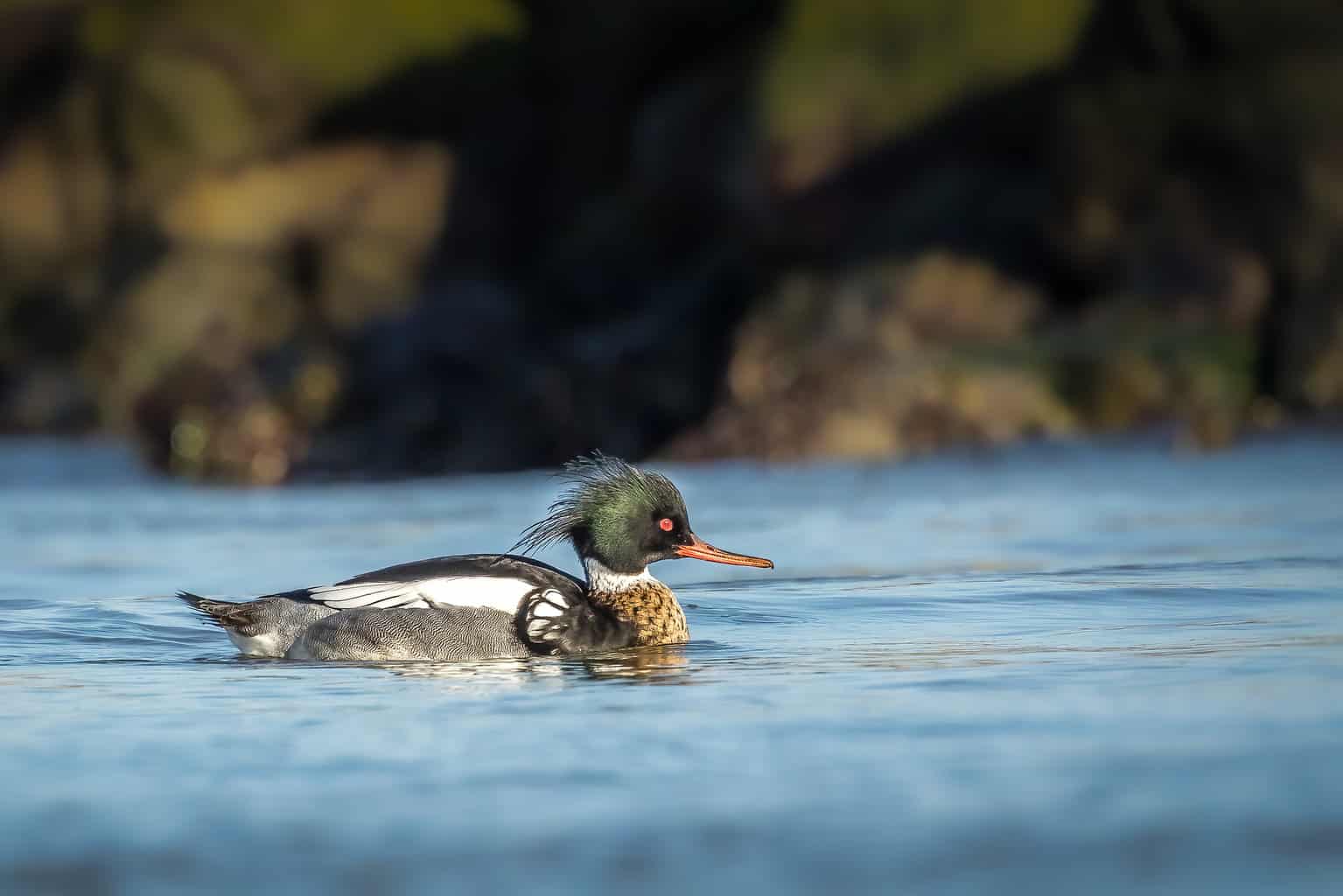
- Scientific Name: Mergus serrator
- Length: 20-24 inches
- Weight: 2.3 pounds
- Wingspan: 28-34 inches
Red-Breasted Mergansers have a truly unique appearance. Their long, shaggy feathers that form a crest along the back of their head are unlike most other ducks on this list.
Females have light brown heads, and males have greenish-black heads. The cinnamon-brown chest of the male is separated from the head by a thick white band around the neck. Females and juvenile males lack that distinctive white band.
In the winter, Red-Breasted Mergansers have a preference for saltwater over freshwater, but they will nest and feed in freshwater if that’s what is available.
These interesting-looking birds don’t stay in North Carolina for long. Their breeding territory is in Canada, and their winter territory is limited to the coastlines of the United States and Mexico.
They will only be spotted in North Carolina when they pause during their long migration.
Because they migrate during the day, instead of overnight, you may get lucky and spot a few. In the spring, they travel only in pairs and relatively small flocks. In the fall, their migration groups can number in the thousands!
Redhead (Diving Duck)
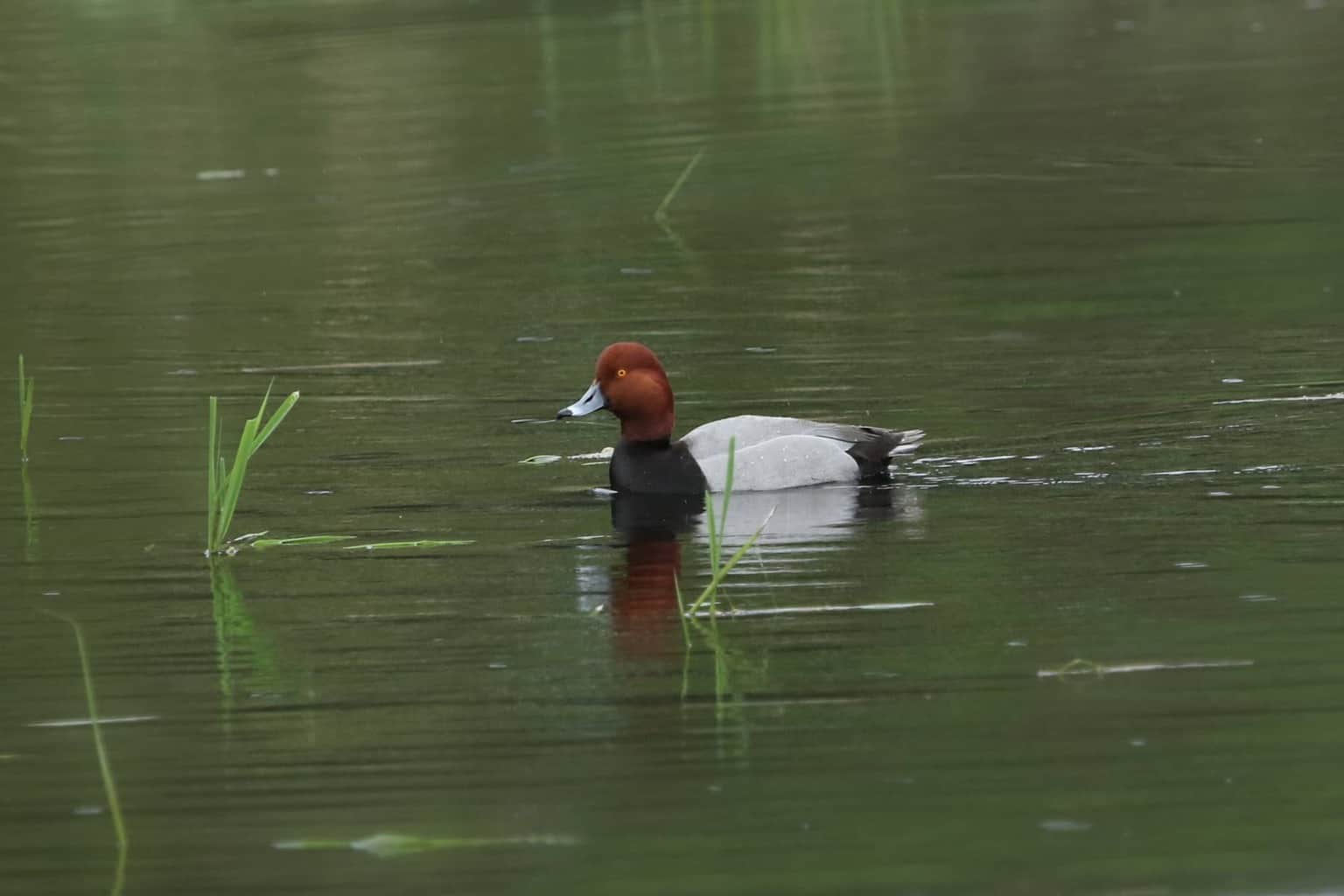
- Scientific Name: Aythya americana
- Length: 18-22 inches
- Weight: 2-2.5 pounds
- Wingspan: 33 inches
The Redhead Duck is another easy-to-identify duck, even from a distance.
Male Redheads have dark, cinnamon-brown heads and black breasts. That vibrantly colored head is visible from far away! Females are very plain in their markings, with light brown feathers all over their bodies.
They have rounded heads and gray flight feathers.
Redhead Ducks are known for migrating in huge groups. There was once a flock of over 60,000 Redhead Ducks! You’ll see Redhead Ducks in the winter in North Carolina after they migrate from the Great Plains states and central Canada.
Their perfect conditions are outside of wooded areas, where there are plenty of dense grasses for nesting. Additionally, they also like deep bodies of water.
Ring-Necked Duck (Diving Duck)
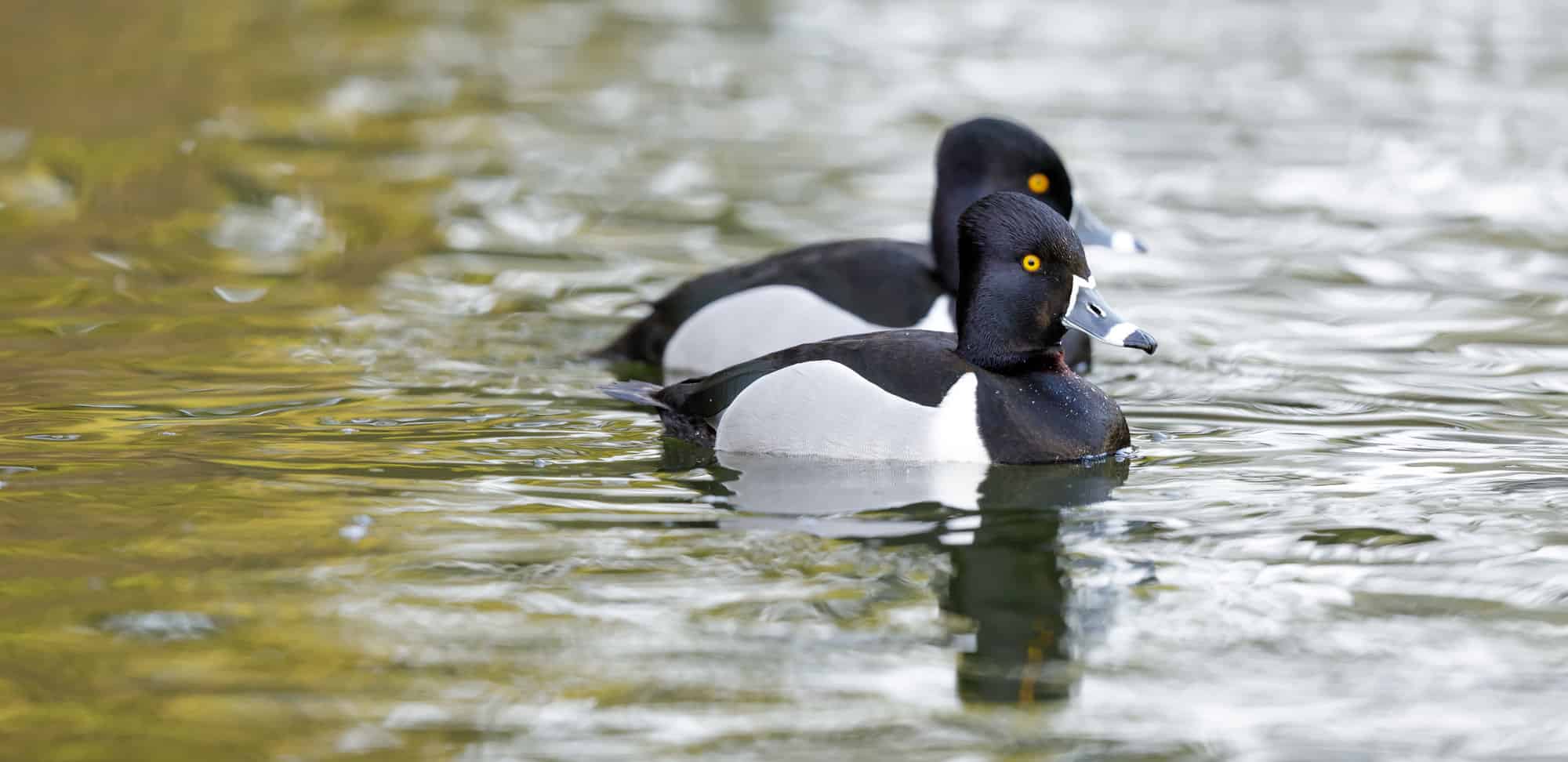
- Scientific Name: Aythya collaris
- Length: 15.3-18.1 inches
- Weight: 17.3-32.1 ounces
- Wingspan: 24.4-24.8 inches
When biologists and naturalists in the 1800s gave the Ring-Necked Duck its common English name, they were learning about the species from dead specimens.
They noticed that the duck has a dark copper ring around its neck, and must have thought, “Perfect! We’ll call this one the Ring-Necked Duck!”
Here’s the problem: the copper ring of the Ring-Necked Duck is nearly impossible to spot in a live, active duck. That makes the name somewhat confusing for birders who don’t know this history.
This duck does have another ring, which is much more noticeable; it has a white ring around its bill.
Additional identifying details include the downward-sloping forehead and small crown.
Ring-Necked Ducks prefer shallower waters than many of their fellow diving ducks. They can be spotted throughout most of North Carolina during the winter, with the exception of the very western edge of the state.
Ruddy Duck (Diving Duck)
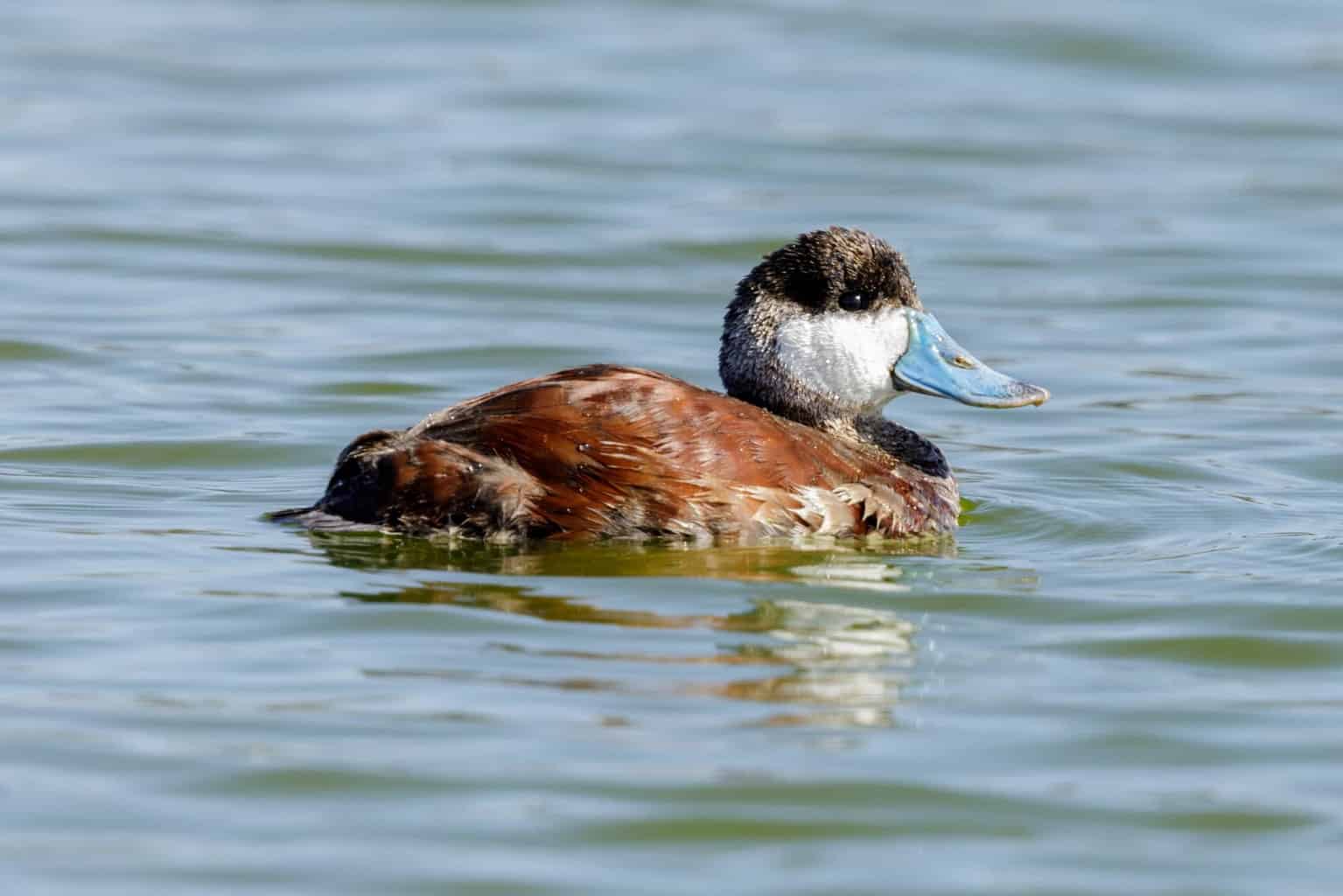
- Scientific Name: Oxyura jamaicensis
- Length: 13.5-17 inches
- Weight: 1.23 pounds
- Wingspan: 18.5 inches
During the summer, male Ruddy Ducks are easy to identify because they have a vibrant blue bill.
Bad news for birders in North Carolina who are trying to identify a variety of ducks: the Ruddy Duck’s bill turns black in the winter.
Females always have black bills, so the blue bill is not very helpful for spotting them, either.
Instead, when it comes to the males, watch for a big white cheek on a dark black head. For females and juvenile males, look for light brown bodies and dark crowns on their heads.
Breeding males also have long, pointy tails that may not be as pronounced as a Pintail duck, but are still noteworthy.
Ruddy Ducks migrate through the western edge of North Carolina and overwinter along the east coast.
Wood Duck (Dabbling Duck)
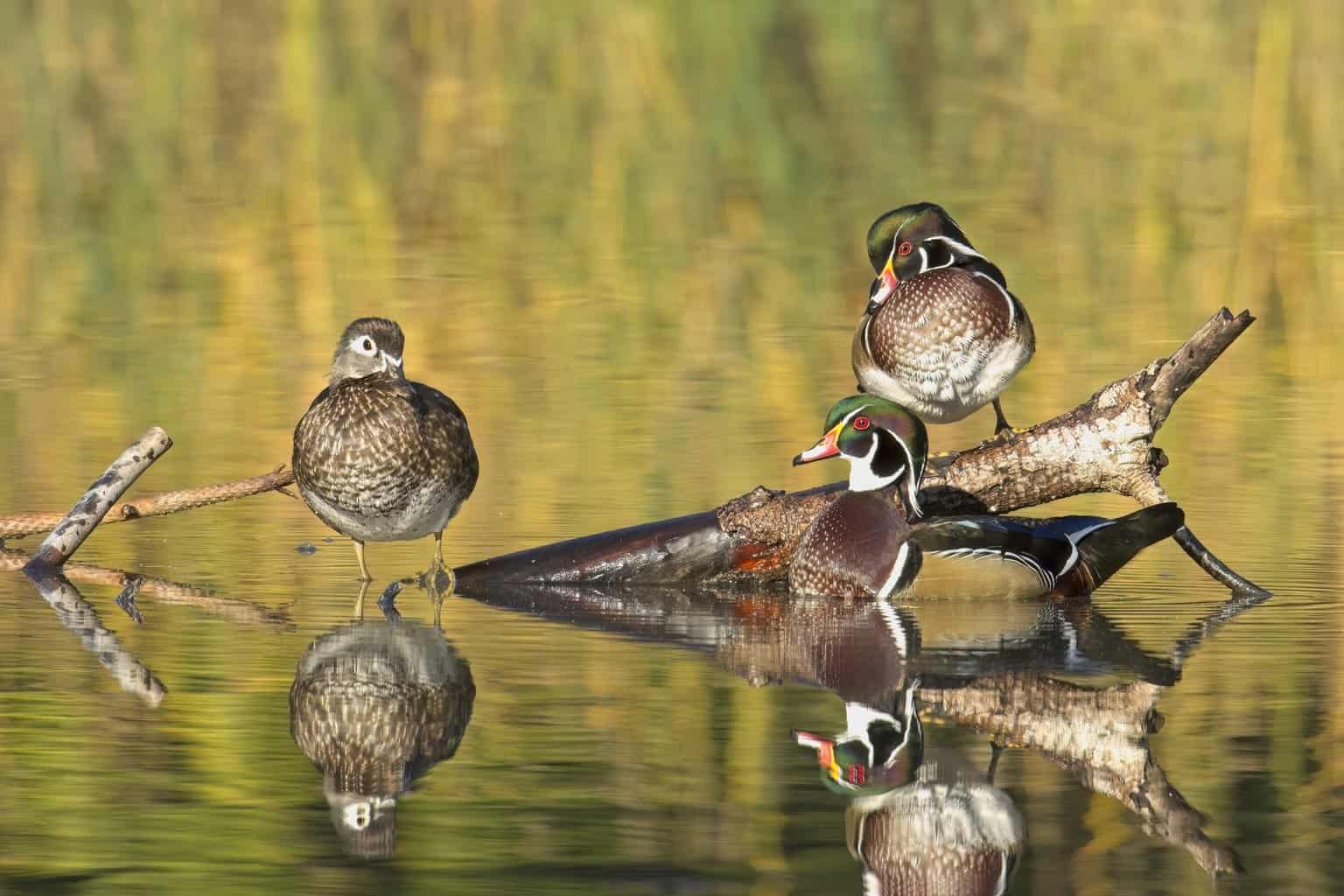
- Scientific Name: Aix sponsa
- Length: 17-20 inches
- Weight: 1.5 pounds
- Wingspan: 28 inches
Perhaps the only duck that can compete with the Mallard for recognizability is the Wood Duck. This dramatic-looking male has a dark, metallic green head and several white stripes along the back of the head and cheeks.
He has a chestnut-brown breast with small white pin dots all over it. Females have a similarly patterned chest, but in grayish-brown instead.
During the non-breeding season, the male loses his bright colorful markings and turns brownish-gray. However, his multi-colored bill keeps its brightness all year long.
Wood Ducks stay in North Carolina all year! They live in rivers and swamps, wetlands and marshes, and ponds. If there are cattails, look for Wood Ducks. Like other cavity-dwelling ducks, Wood Ducks live in the holes left behind by other birds.
Final Thoughts
North Carolina’s many birds offer something special to both visitors and residents alike. There are so many species here, including at least 19 duck species.
Some ducks are here year-round, whereas others are only present for the winter or during their migration. By using clues like their appearance, habitat, nesting behaviors, and diet, you can usually identify what kind of duck you have encountered!
Watch out for some of our beautiful ducks and keep a list of what you see! Whether you are camping, hunting, hiking, commuting, or even just watching the birds from your window, you never know what fascinating duck may end up in the waters nearby!

